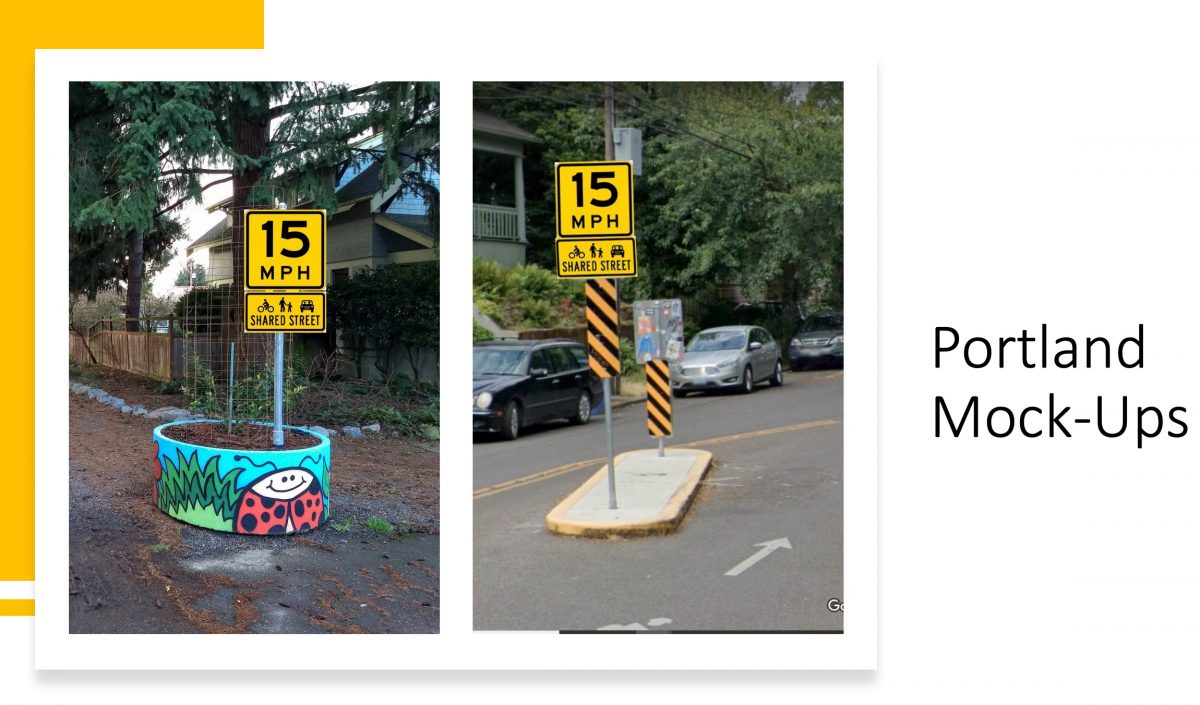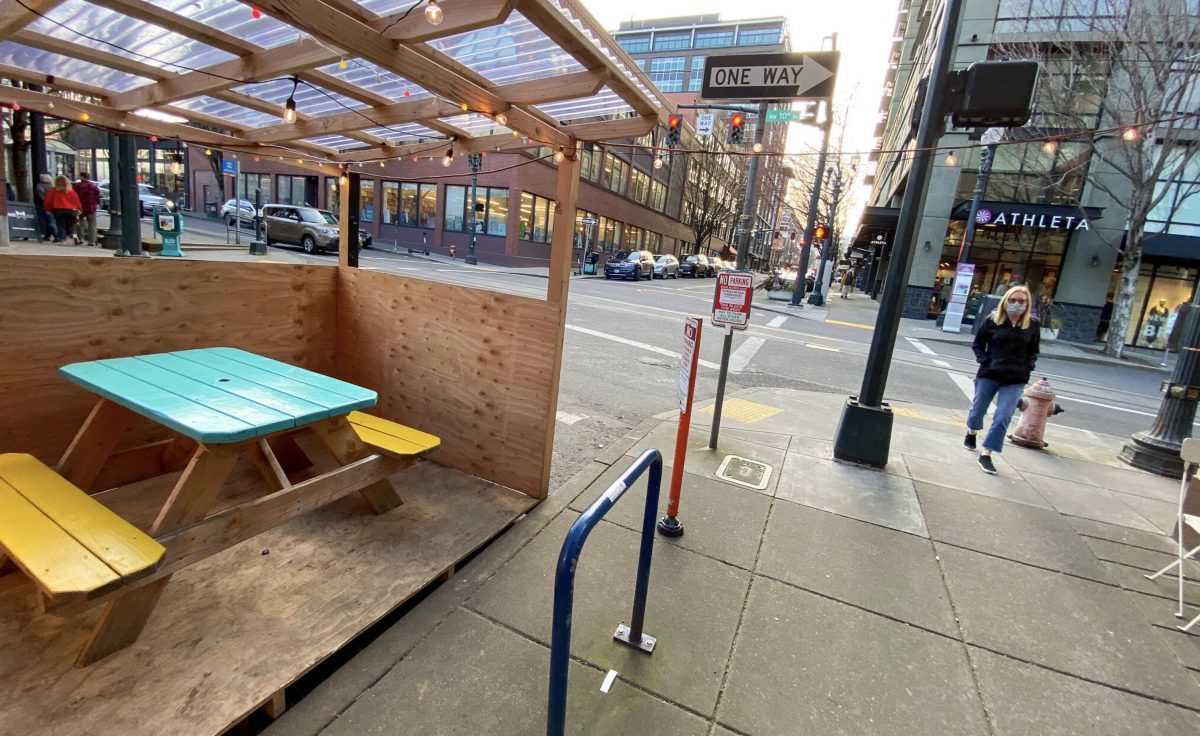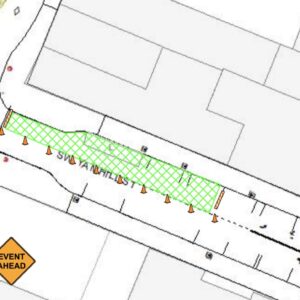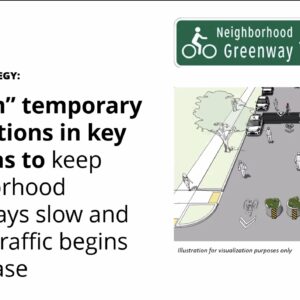
(Photos: Jonathan Maus/BikePortland)
It’s been almost 11 months since the Portland Bureau of Transportation launched the Slow Streets program in response to a dramatic increase in walking and biking citywide at the outset of the Covid-19 pandemic.
Now the question is: What comes next? Will PBOT gather up all the signs and barrels and open streets back up to drivers? Or will they transition the program into a lasting network of safer streets?
There are currently 210 installations of orange barrels and small barricades on residential streets throughout Portland, installed to encourage car and trucks drivers to slow down, take alternate routes, and leave the streets for people on foot, bikes and other mobility devices.
Slow Streets was one of three pillars of PBOT’s response to the pandemic. They also created a Healthy Business permit program that encouraged outdoor dining and carfree plazas; and implemented infrastructure updates through their Safer Busy Streets program.
As the threat of Covid recedes thanks to vaccinations, PBOT wants to extend these efforts and make some of the changes permanent.
Advertisement
What PBOT is thinking (and hearing)

“We need to be physically distanced now, but we need community always.”
— Scott Cohen, PBOT
PBOT Program Coordinator Scott Cohen shared an update on the Slow Streets program with the city’s Bicycle Advisory Committee earlier this month. He acknowledged that PBOT initially planned for the car traffic diverters to only last for three to six months. “And here we are in month 11… and we’re asking some questions: How do we keep providing this need efficiently? And how do we adapt and retain flexibility? How can we better engage on the public health focus and with our BIPOC community organizations?”
Cohen added that PBOT sees a continued demand for the installations and their benefits.
A text-based survey on the installations that received nearly 1,000 responses informed PBOT that the temporary diverters are not only giving people more, lower-stress space to walk and bike, they give people a stronger sense of community. “A stronger community is a benefit that will last beyond the pandemic,” Cohen said. “We need to be physically distanced now, but we need community always.”
Cohen is also aware that it’s been a tough winter on the signs and barrels as many installations have been vandalized, banged up, or moved — all of which has driven up maintenance costs. Even so, given the positive evaluation of the program thus far, PBOT seems poised to make at least parts of it permanent.
“What we need to do is to adapt this program to something that is more resilient,” Cohen said as he shared examples of neighborhood traffic diverters from other cities and mock-ups he envisions for Portland (that included 15 mph speed limit and “shared street” signage!).
Future installations could include signage that leads people to vaccination sites or that share other important public service messages, Cohen said. Transforming the diverters into permanent public art is also something PBOT is considering. No complete list has been shared yet, but Cohen mentioned a permanent diverter will be coming to SE Salmon and 30th.
“I would like kids to be able to bike to school when they go back to school.”
— Catie Gould, Bicycle Advisory Committee
Bicycle Advisory Committee members fully supported the program and pushed PBOT to go even further.
Kelly Hansen said she wants to make ones installed on NE Tillamook and 92nd near Jason Lee School permanent. “I’ve biked there during rush-hour pre-Covid and I felt like no kids could bike to school because there were a million cars on the greenway,” she said.
BAC Chair David Stein encouraged PBOT to “take a more aggressive stance” on replacing the barrels and signs with concrete diverters.
BAC member Catie Gould said she’s concerned PBOT hasn’t done enough to make greenway streets safer during the pandemic. “There’s not been a huge difference for me in the quality of bicycling on greenways and I feel like within a few months [traffic conditions] might change dramatically.” Gould also said she wants to see PBOT convert these installations to concrete traffic diverters. “I’m not sure why we’re saying these aren’t [permanent, concrete] diverters or that we’d deploy them in a way that isn’t going to stop cars… Because I would like kids to be able to bike to school when they go back to school.”
PBOT’s Cohen seemed to agree with these sentiments, but made it clear they must weigh other perspectives. “The orange barrels were great in the beginning. And then maybe it’s concrete barrels, and then it’s maybe more concrete barrels to actually act as a diverter. I think these are steps on the road to making the street network and the greenway network operate better. But we’ve got to bring people along with us.”
Expect a big announcement next month
In the coming weeks, I have a hunch PBOT is going to make a big announcement about the next phase of these programs.
On March 10th, they announced an extension of their Healthy Business permit program through October 2021 based on its broad support and popularity (over 1,000 permits have been issued so far) with restaurant and cafe owners. A survey with over 3,000 respondents taken in September revealed that 78% of people who responded felt safe dining outdoors and a whopping 94% of them said the outdoor dining parklets and carfree plazas should continue.
PBOT also announced they’re evaluating a new permit option, “for residents to safely activate their neighborhood streets.” (The beloved PBOT Block Party permit program has been suspended due to Covid ever since last spring.) We’re working to get more details on this.
Another good sign that these programs aren’t going anywhere is that PBOT recently won a $47,600 grant from Travel Oregon to create new signage and placemaking around 20 Healthy Business plazas.
And then there’s Sunday Parkways. The 2020 edition was all virtual, but given where we’re at with the pandemic and the lessons PBOT has learned about open streets, I have a hunch they have something up their sleeve for this year’s events. Perhaps a hybrid event (or events) where they cordon off a route with barricades and intersection monitors, but forego the activity hubs and food vendors in the parks? This would give people the chance for carfree walking and rolling while discouraging large groups.
Asked about this possibility yesterday, PBOT Communications Director John Brady said, “We’ll be making an announcement in mid-April. Until then, I’m not going to spoil any surprises.”
Stay tuned.
— Jonathan Maus: (503) 706-8804, @jonathan_maus on Twitter and jonathan@bikeportland.org
— Get our headlines delivered to your inbox.
— Support this independent community media outlet with a one-time contribution or monthly subscription.











Thanks for reading.
BikePortland has served this community with independent community journalism since 2005. We rely on subscriptions from readers like you to survive. Your financial support is vital in keeping this valuable resource alive and well.
Please subscribe today to strengthen and expand our work.
I hope that the Healthy Business program can be made permanent (in a way that isn’t as expensive and bureaucratic as the street seats program). In the handful of places where the plazas touch the greenway network (28th & Ankeny; 26th & Clinton) they have the very nice side effect of as acting as really effective diverters.
I hope so too, with the caveat that street seat structures need to be positioned away from intersections (20 foot rule). There are several places where they run right up to the crosswalk, blocking the view of both cyclists and motorists. Eastbound E Burnside between Grand and 10th is one example.
I’d be pretty pumped if they actually put down legit diverters. At this point I don’t come across any that aren’t chucked to the side. If it seemed like they worked at first, I think that was just because traffic had fallen off a cliff. I’ve been biking to work all this time, can’t do my job remote, and traffic feels damn near up to where it was and I’m getting tailed by impatient drivers on side streets just like February 2020. So, legit, hard barriers or nothing. These things out there now, it’s just more eyesore trash all over the place, adding to all the actual trash all over the place.
(nothing here worth moderating, JM!)
I’d agree with PTB on this one. Out where I’m at they are just becoming trash and visual clutter and don’t really do much to change the streets.
Did you read the story PTB? I mean, this is what PBOT is asking about… they want feedback on how to create a program where they can transition to more “legit diverters”. Have a hunch they’ll be releasing some sort of public outreach survey in the near future. Stay tuned!
I did read it! And I’d be pretty pumped on hard diverters! I mean, wouldn’t we all??
But they’ve got to, you know, actually divert traffic. Not just some warm, fuzzy message about slowing down for others and stuff like “this street is a community” or some bogus message that doesn’t actually make people slow down. Posi messages don’t keep cars from running into things.
Dude, you are killing me with this moderation!
It’s not just you PTB. Every single comment is moderated. New policy as of a few weeks ago where I heard lots of criticism about letting too much crap through the filter.
Got it. Noted. I thought I was being singled out. I’m sensitive!
I had the same initial reaction, PTB – I’m sensitive too.
So are we stuck in the seven levels of PBOT hell? The streets have already been studied to death. Despite PBOT’s fears, the beg signs didn’t create a traffic apocalypse, and now we need to do to more exhausting and pointless “community outreach” to find out how to install diverters to make the greenways actually green?
Spoiler: NIMBYs will quake about emergency vehicles and PBOT will decide it’s just to gosh darn hard to install the hard infrastructure. We will probably hear that it hurts equity to install the diverters and we will settle for some kind of enhanced signage and some random green paint on the road.
Looking forward to Sunday Parkways this summer! It’s always shocking how many cyclists are in the wings, waiting for the opportunity to feel safety in numbers on our streets.
You can look forward to Sunday Parkways in every part of the city EXCEPT Southwest, which doesn’t have the program thanks to the many angry drivers who complained bitterly about not being able to drive everywhere, plus a lack of volunteers in this part of town.
I vote for less flexibility. Permanent diverters that can’t be moved 5 minutes after they’re put in place, thrown to the side of the road or in the middle of sidewalks because neighbors/businesses don’t want to slow down traffic.
How about an actual traffic light at that intersection? There is constant cut-through traffic that refuses to stop for anyone crossing there. Salmon with diverters will be nice, but it’s 30th that needs calming through infrastructure.
I’m kind of confused. The word “diverter” is used, but the signs are not diverters. Are they actually thinking of making greenways safe by diverting motorized traffic? Or is the plan to make the useless beg signs permanent by sticking them in concrete?
N Central is a major speeding cut through route for traffic between NW Oregon/NW Portland and Washington and it makes it pretty unusable during the week (not to mention the motorized cluster that is Roosevelt) and I promise you, motorist do not care about the beg signs or at this point, stop signs on N Central. Almost got destroyed a week ago.
From what I understand, people are free to move the signs around. Pbot had requested neighbors to be more involved with how this rolled out. Also, not all diverter are meant to redirect to a different street but to slow people down.
The diverter just north of I-84 on 53rd has now been stolen, or trashed. It was a battle over the past year between one grumpy older guy and the rest of us. He kept moving them out of the way, and we kept moving them back. I guess he finally decided to just steal them.
Hi neighbor! I live just a half block north of that diverter.
When it disappeared a month or so ago, I emailed PBOT and asked what happened to them. They said “We did remove those signs intentionally. Someone has been repeatedly moving the signs directly into the road, and we just can’t keep fixing them.”
It looks like they’ve since been brought back but if you are moving the signs around, just be careful that they are going back where the spray paint indicates they should be otherwise PBOT has to send crews out and they might remove them again.
I like how this program seems to be moving forward logically–starting with temporary installations, making adjustments, giving people a chance to see how things worked, then moving towards making permanent changes. I like the 15 mph/shared street mockup signs. I brought up an issue with an installation to the program early on, and Scott Cohen responded right away.
I had to laugh when I read “What comes next? Will PBOT gather up all the signs and barrels and open streets back up to drivers?”
News flash! – the streets are already open to drivers and always have been. From what I’ve observed in SW Portland, no driver has been deterred by the signs and bollards. This whole program is Performative Portland at its best, which I define as “The art of looking like you’re doing something without actually doing anything.” It allows Portland city gov’t to say “Look, cyclists! We did something to improve your cycling conditions. Now shut up and go away.”
On the other hand, starting out with temporary signs and voluntary compliance allowed the program to get started sooner, and avoided the extreme backlash that would have happened if it had started out with actual barricades and/or permanent installations.
It also allowed PBOT to collect data that shows lots of people like the program, and data that the signs don’t last and too many people don’t voluntarily comply, giving PBOT great arguments for continuing the program, but with permanent barriers.
As a native Russian speaker, I wish PBOT would hire actual translators when they put up signage in other languages. The translation of “Want to volunteer” on the pictured sign in Russian actually says “Want a volunteer?”, an expression that has a clear erotic undertone in Russian. It’s equal parts amusing and a showcase of PBOT’s incompetence or failure to do things right the first time, in my opinion.
LOL, thanks for this. Made my day. Спасибо.
I’m pleasantly surprised to hear that a permanent diverter is coming to Salmon and 30th. Diverters had been placed on Salmon at that intersection to discourage people from turning from 30th onto Salmon in either the eastbound or the westbound direction, and to prevent cars from using Salmon as a through street. But several months ago, PBOT retreated from the original diverter arrangement at that intersection. The moved the westbound diverter a block to the west. It’s now located at the intersection of Salmon and 29th. They moved the eastbound diverter to Salmon and 34th. Now there are no signs or barrels at the intersection of Salmon and 30th at all. I had assumed that this meant that PBOT was just giving up on that intersection altogether. This is great news if they plan on installing something permanent in the original location! I hope it is a full diverter with actual ‘Do Not Enter’ signs and physical barriers.
I hope that many more of these diverters will go in on greenways around the city. But we also need to be looking at diverters on the north/south streets that cross the greenways. The N Central greenway has a massive problem that is caused by traffic that is cutting through the neighborhood from Lombard and the St Johns bridge on their way to destinations to the north, such as industrial areas and Columbia Blvd. The cross traffic, which oftentimes completely ignores stop signs and does not yield to through traffic on N Central, poses a much bigger problem than the vehicles that are actually driving on Central. Cut through traffic is also a big problem on the Clinton greenway.
The things put up at the beginning of Covid didn’t work for my intersection. They ended up run over, flattened, toyed with etc. When I asked about putting up something more permanent, their solution was to take away and move what they had put up. Still don’t know how this is a solution. Something more permanent, a concrete barrier or whatever, can’t be as easily ignored or picked up and slammed to the ground. In the past three weeks, we have had two shootings resulting in two deaths and one injury on my block at K-Park. So, I’m all for something more permanent to not only slow traffic down but to also keep the shooters in their cars from using my block as a shooting range.
Deborah, I think you may have hit on an overlooked point of these Eudaly signs, which has come to mind for me from time to time. I’m unaware of any research on diverting cut-through traffic on residential streets correlating with a statistically significant reduction in drive-bys. I’d be interested to see if there is one.